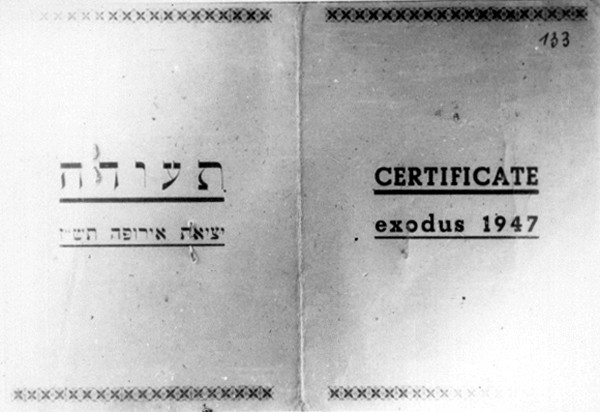"President Warfield – Exodus 1947"
"Exodus" sailed from Sete port in France on July 11th 1947, with 4,515 immigrants from the refuge camps on board.
The "President Warfield – Exodus 1947" Haapala ship (bilingual name in English and Hebrew) was prepared for its departure to Israel in the Baltimore and Norfolk ports in the U.S, in Porto Venero, Italy and in the Marseille and de Boeck ports in France. The preparation crews were headed by Ze'ev Sheind and Avraham Zakai.
"Exodus" had previously served as an American cruise ship baring the name "President Warfield" (named after the president of the company who built it.) During WWII, the ship was leased to Britain for transporting corps to the La Manche Channel. After the war, the ship was returned to its American owners and was purchased by Ze'ez Sheind, an envoy from 'Hamossad for Aliyah Bet,' while it waited to be dismantled.
The commander of the "Exodus" was Yossi Hamburger (Harel.) The captain of the ship was Itzhak (Ike) Aharonovitch. The 'Gidonim' were Azriel Einav and Max Cohen. Additional escorts were Palyam member, Zvi Kazhenelson, who dealt with the administration; Micha Pearlson (Perry), who was in charge of order and security, and Palmach member, Sima Schmukler, who was in charge of medical service. The ship crew was made up of thirty six American volunteers, two of which were not Jewish.
"Exodus" sailed from Sete port in France on July 11th 1947, with 4,515 immigrants from the refuge camps on board. The ship was forced to sneak out of the port by complex maneuvering, since the French authorities refused to approve its departure due to heavy pressure by the British. "Exodus" left after a two-month break in the Haapala endeavor, due lack of finance and manpower in 'Hamossad for Aliyah Bet.'
The unique journey of the "Exodus" immigrants was gradually revealed, bit by bit:
The moving broadcast to the Jewish Yishuv on the eve of its arrival; the long drawn battle before the country shores; the disembarkation in the presence of the UN commission of inquiry (UNSCOP) members in Haifa port; the return to Europe, which was only made known two days after the three deportation ships had left Haifa; the long stay on board the ships due to the immigrants' refusal to run ashore; and finally – the immigrants' deportation to Germany; the attempt to sabotage one of the deportation ships and the hardships they suffered until the very last of them made it to Israel in September 1948.
The history of "Exodus" and the international response it received have turned it into a symbol and a model of the Haapala endeavor. "Exodus" expressed the willful and determined struggle of the Jewish nation for free immigration to Israel.
"Exodus" had previously served as an American cruise ship baring the name "President Warfield" (named after the president of the company who built it.) During WWII, the ship was leased to Britain for transporting corps to the La Manche Channel. After the war, the ship was returned to its American owners and was purchased by Ze'ez Sheind, an envoy from 'Hamossad for Aliyah Bet,' while it waited to be dismantled.
The commander of the "Exodus" was Yossi Hamburger (Harel.) The captain of the ship was Itzhak (Ike) Aharonovitch. The 'Gidonim' were Azriel Einav and Max Cohen. Additional escorts were Palyam member, Zvi Kazhenelson, who dealt with the administration; Micha Pearlson (Perry), who was in charge of order and security, and Palmach member, Sima Schmukler, who was in charge of medical service. The ship crew was made up of thirty six American volunteers, two of which were not Jewish.
"Exodus" sailed from Sete port in France on July 11th 1947, with 4,515 immigrants from the refuge camps on board. The ship was forced to sneak out of the port by complex maneuvering, since the French authorities refused to approve its departure due to heavy pressure by the British. "Exodus" left after a two-month break in the Haapala endeavor, due lack of finance and manpower in 'Hamossad for Aliyah Bet.'
The unique journey of the "Exodus" immigrants was gradually revealed, bit by bit:
The moving broadcast to the Jewish Yishuv on the eve of its arrival; the long drawn battle before the country shores; the disembarkation in the presence of the UN commission of inquiry (UNSCOP) members in Haifa port; the return to Europe, which was only made known two days after the three deportation ships had left Haifa; the long stay on board the ships due to the immigrants' refusal to run ashore; and finally – the immigrants' deportation to Germany; the attempt to sabotage one of the deportation ships and the hardships they suffered until the very last of them made it to Israel in September 1948.
The history of "Exodus" and the international response it received have turned it into a symbol and a model of the Haapala endeavor. "Exodus" expressed the willful and determined struggle of the Jewish nation for free immigration to Israel.














